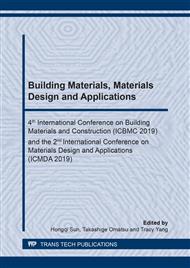[1]
Yu. M. Bazhenov: Technology of Concrete (in Russian) (Higher School, Moscow, Russia 1987).
Google Scholar
[2]
V. I. Zaprudnov: Proceedings of Moscow State Forest University Vol. 285 (1996), p.12.
Google Scholar
[3]
F.C. Jorge, C. Pereira, J.M.F. Ferreira: Holz als Roh- und Werkstoff Vol. 62(5) (2004), p.370.
DOI: 10.1007/s00107-004-0501-2
Google Scholar
[4]
Y. Zhou, D.P. Kamdem: Forest Products Journal Vol. 52 (2) (2002), p.73.
Google Scholar
[5]
R.M. Ronquim, F. S. Ferro, F.H. Icimoto, C. I. Campos, M.d.S. Bertolini, A.L. Christoforo, F. A. R. Lahr: International Journal of Composite Materials Vol. 4(2) (2014), p.69.
Google Scholar
[6]
K. E. Semple, P.D. Evans: Wood and Fiber Science Vol. 39(1) (2007), p.120.
Google Scholar
[7]
K. E. Semple, R.B. Cunningham, P.D. Evans: Holz Roh- Werkstoff Vol. (58) (2000), p.315.
Google Scholar
[8]
A. Matoski, S. Iwakiri: Floresta Vol. 37 (2007), p.149.
Google Scholar
[9]
K. E. Semple, R.B. Cunningham, P.D. Evans: Holzforschung Vol. 53(3) (1999), p.327.
Google Scholar
[10]
Y.A.M. Cheumani, M. Ndikontar, B.De Jéso, G. Sèbe: J Mater Sci Vol. 46 (2011), p.1167.
Google Scholar
[11]
C.F.A. Parchen, S. Iwakiri, F. Zeller et al.: Eur. J. Wood Prod. Vol. 74 (2016), p.75.
Google Scholar
[12]
H.A. Abdelrhman, M.T. Paridah, M. Shahwahid, et al.: Eur. J. Wood Prod. Vol. 73 (2015), p.557.
Google Scholar
[13]
V. I. Zaprudnov: Forestry Bulletin Vol. 5 (2013), p.203.
Google Scholar
[14]
V. I. Zaprudnov: Forestry Bulletin Vol. 6 (2017), p.54.
Google Scholar
[15]
A. S. Scherbakov, V. I. Zaprudnov: Forestry Bulletin Vol. 5 (2013), p.200.
Google Scholar
[16]
A. S. Shcherbakov, L. P. Khoroshun, V. S. Podchufarov: Arbolit. Improving of the quality and durability (in Russian) (Forest industry, Moscow, Russia 1979).
Google Scholar
[17]
S. Frybort, R. Mauritz, A. Teischinger, U. Muller: BioResources Vol. 3(2) (2008), p.602.
Google Scholar
[18]
V. I. Zaprudnov: Forestry Bulletin Vol. 2 (2016), p.127.
Google Scholar
[19]
V. S. Podchufarov, T. A. Chemleva, A. S. Scherbakov: Proceedings of Moscow Forest Technical Institute Vol. 93 (1976), p.68.
Google Scholar
[20]
I.A. Ryb'ev: Building Materials Vol 1. (1965), p.17.
Google Scholar
[21]
B. N. Ugolev: Wood Science and Forest Products (in Russian) (Moscow State Forest University, Moscow, Russia 2007).
Google Scholar
[22]
V.G. Sanaev, V.I. Zaprudnov, G. A. Gorbaheva, A. N. Oblivin: Bulletin of the Transilvania University of Braşov, Series II: Forestry • Wood Industry • Agricultural Food Engineering Vol. 9 (58) No.2 (2016), p.63.
Google Scholar
[23]
A.N. Papadopoulos, G.A. Ntalos, I. Kakaras: Holz als Roh- und Werkstoff Vol. 64(6) (2006), p.517.
DOI: 10.1007/s00107-005-0092-6
Google Scholar
[24]
G. Schmitz: Elektrische mechanische und thermische untersuchungen über das system holz-zement (Dusseldorf, Germany 1968).
Google Scholar
[25]
V. I. Zaprudnov: Forestry Bulletin Vol. 1 (2015), p.21.
Google Scholar
[26]
A. S. Scherbakov, V. I. Zaprudnov: Forestry Bulletin Vol. 3 (2012), p.130.
Google Scholar
[27]
A. S. Scherbakov, V. I. Zaprudnov: Forestry Bulletin Vol. 4 (2012), p.97.
Google Scholar
[28]
W. Sandermann, P. Kohler: Holzforschung Vol. 18 (1964), p.53.
Google Scholar
[29]
R.H.T. Yeh: J. Appl. Phys. Vol. 44 (2) (1973), p.662.
Google Scholar
[30]
K. Semple, P.D. Evans: Wood Fibre Sci Vol. 32(1) (2000), p.37.
Google Scholar
[31]
Y.M. Wei, Y.G. Zhou, B. Tomita: J Wood Sci Vol. 46 (2000), p.296.
Google Scholar
[32]
Y.M. Wei, B.Tomita: J Wood Sci Vol. 47 (2001), p.437.
Google Scholar
[33]
S. Yasuda, K. Ima, Y. Matsushita: J Wood Sci Vol. 48 (2002), p.242.
Google Scholar
[34]
K.B. Boadu, C. Antwi-Boasiako, L.Ofosuhene: J Indian Acad Wood Sci Vol. 15 (2018), p.140.
Google Scholar
[35]
A. Sales, F. R. Souza, F. C. R. Almeida: Construction and Building Materials Vol. 25 (2011), p.2793.
Google Scholar


